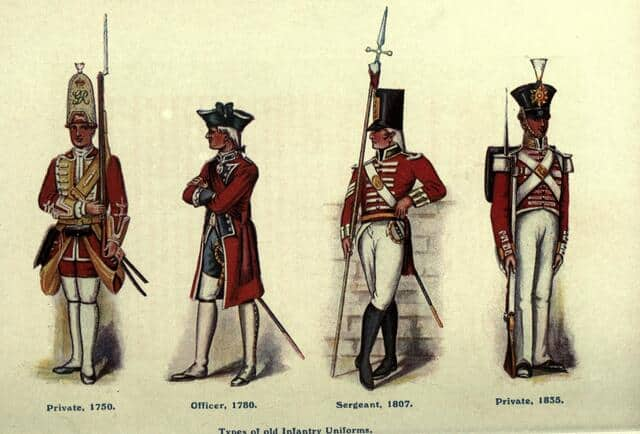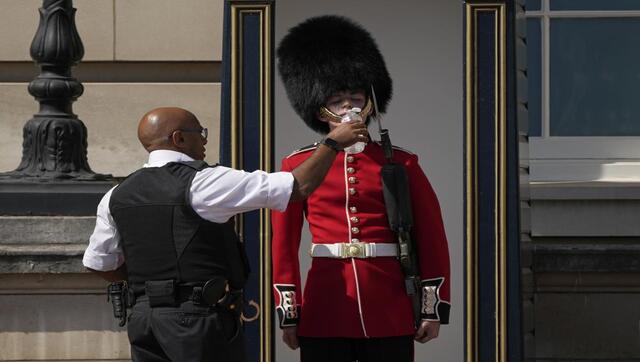There is one obvious point to make upon seeing the flushed face of the young British guard at Buckingham Palace being ceremonially brought a cup of water by fellow guards as temperatures soared in the UK this July: get rid of those bearskin hats and shift to sola topees, used during the days when the sun never set on the British Empire. The heat is on to change old practices, not merely because there is an Asian contender for 10 Downing Street.
A member of the Queen's Guard receives water to drink outside Buckingham Palace in London, with Britain on course for its hottest day on record https://t.co/bb4Th0gZBh 📷 @John_Sib pic.twitter.com/9wfBySVbC9
— Reuters (@Reuters) July 18, 2022
Based on similar cooling headgear used by colonial powers across tropical Asia, sola topees were introduced in the 1840s by the British using the cooling pith of sola reeds. And despite its colonial roots, India’s police forces still use them though today they are made of coir and lined with thermocol. As the Royal Marines still use a version of the topee for its ceremonial headgear, it would be no skin off any one’s nose to use them more widely in the UK. For a long time, it was easy to be imperiously oblivious of differences in temperatures and force preferences onto others in the name of ‘proper’ work attire. Hence, the British made sure that buttoned-up, tight clothing meant for, say, London, Bristol, Cardiff, Manchester and Dundee would also be worn in Lucknow, Bombay, Calcutta, Madras and Delhi. These diktats not only ingrained a colonial mindset but ensured the reign of air-conditioners today. Men — the British and their Indian bureaucratic and managerial staff — wore the same sort of clothing in the colonial era: a shirt with a knotted tie cutting off circulation around the neck, trousers, a coat buttoned in the front, and socks with closed shoes. The Memsahibs’ primly buttoned up, long-sleeved Victorian gowns were mimicked by their elite Indian counterparts in the form of elaborate blouses and petticoats being added to the classic unfettered saree drape. [caption id=“attachment_10971981” align=“alignnone” width=“640”]  Types of old infantry uniforms of the British army. Wikimedia Commons/Regimental Nicknames and Traditions of the British Army[/caption] In the days before electricity (and air-conditioning), those inappropriately attired Sahibs and their Mems had punkhawalas tugging ropes to swing fans and keep it breezy indoors; wet khus panels turning dry hot loo winds into cooling zephyrs added to their comfort. But they forgot (or could not afford) these cooling hacks once they returned from the colonies. Hence their clothing and homes remain stifling and unventilated during the current Ice Cube Age. [caption id=“attachment_10972151” align=“alignnone” width=“640”]  A woman reading under a punkah in a comfortably furnished room. Inscribed on reverse: ‘Mrs Gladstone Lingham’s drawing room at her residence in Berhampore, 1863’. Wikimedia Commons/ British Library[/caption] Indians today have it a little better than average Britons as ceiling and table fans are fairly common now even in the most modest homes as well as more efficient air-coolers. And well-heeled Indians have air-conditioners in their homes, offices, schools and cars. But in Europe and the UK, heating and heat conservation have remained the main goals, not central cooling. So punkhawallas (as fan sellers now, not tuggers) may become indispensable again. Even if Britons do discover the joy of electric punkhas, ceilings in their homes are mostly too low for installation as fans are basically mini helicopter rotor blades spinning not too far above people’s heads. Wall fans and standing ones are equally hard to install or expensive. Nor can picturesque old row houses and cottages and council flats be replaced with high ceilinged, verandahed colonial bungalows or modern housing suited to high temperatures. So the safest option would be to change British sartorial habits rather than risk decapitation or fork out high sums for air-conditioners. There is enough reason now for a shift to more climate-appropriate clothing, in cooling rather than heat-retaining fabrics and styles. Suits simply do not suit all-weather wear anymore. Whereas once Western norms of attire dominated, it is time for UK’s residents to ditch that superiority complex and go eastern, at least in summer. That does not mean looking like those faintly embarrassed foreigners dressed in baggy kurta-pajamas and salwar suits at Indian weddings. It entails men wearing single-layer natural fabrics (with an absorbent inner in the form of singlets or banians during humid weather) in loose — but not shapeless — cuts that allow air circulation. Women also have the additional option of airy summer frocks. These styles have to be rebranded as workwear instead of leisure. Offices in the West had made one concession to work attire long ago in the form of Friday dressing but that was not due to climate change concerns. As formal pinstriped office wear and tie sales began to decline, the pandemic arrived in 2020 and demonstrated that stuffy suits are not necessary at all. Dress codes relaxed but work continued apace online. Predictably office wear sales then nosedived in the UK along with the general downswing in clothes sales. The time is just right to effect a paradigm sartorial shift in UK and the rest of Europe currently sweltering in high heat and humidity, even as they contemplate a freezing winter due to a crunch in gas coming from Russia. The climate is changing so people need to change too. Given that their palates are increasingly accepting flavours from around the world, the rest of their bodies should also follow suit. Metaphorically speaking only, of course! Extreme temperatures can be dealt with. Northern India sees them swing from the high 40s (centigrade) to single-digit lows. So woollens are worn in winter in lieu of central heating and heat-retaining homes, and thin fabrics are the norm for summer. Except in those professions or offices that still unthinkingly stick to Western norms of attire aided by air-conditioning. The UK has to recondition attitudes and ditch bearskin hats for sola topees, literally and otherwise. The author is a freelance writer. Views expressed are personal. Read all the Latest News , Trending News , Cricket News , Bollywood News , India News and Entertainment News here. Follow us on Facebook, Twitter and Instagram.


)

)
)
)
)
)
)
)
)



